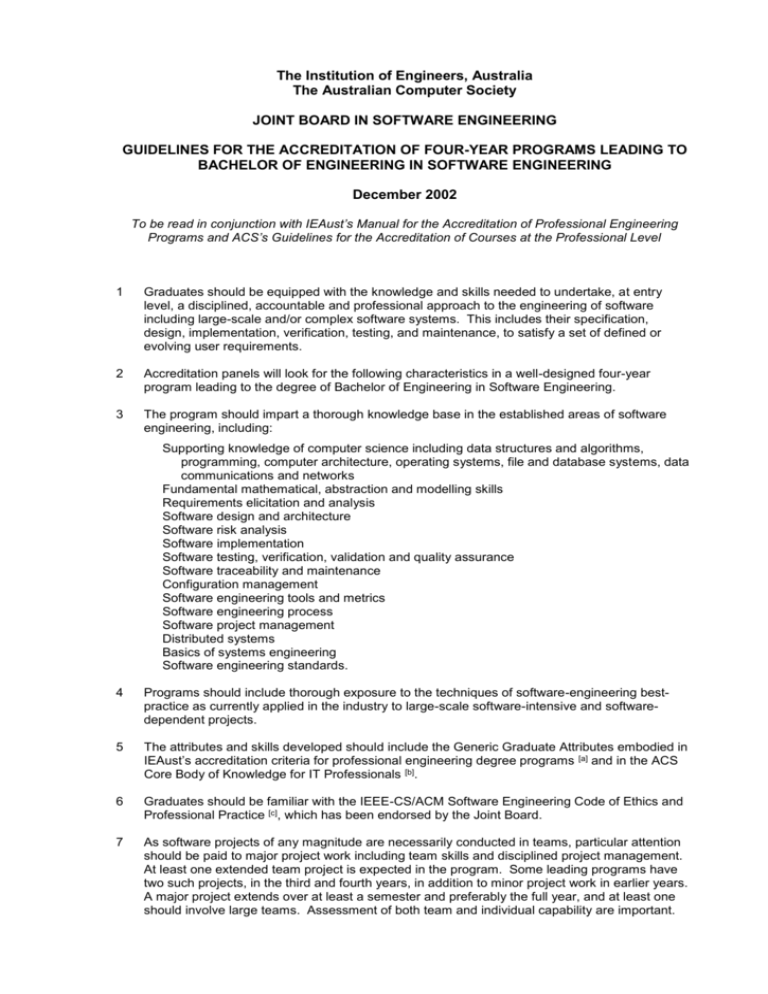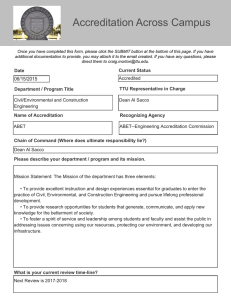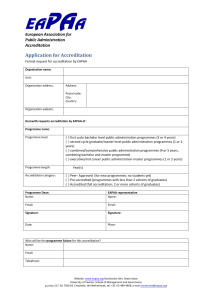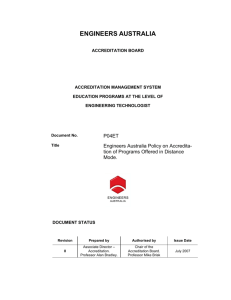Guidelines for Software Engineering (ACS) Dec 2002 Update
advertisement

The Institution of Engineers, Australia The Australian Computer Society JOINT BOARD IN SOFTWARE ENGINEERING GUIDELINES FOR THE ACCREDITATION OF FOUR-YEAR PROGRAMS LEADING TO BACHELOR OF ENGINEERING IN SOFTWARE ENGINEERING December 2002 To be read in conjunction with IEAust’s Manual for the Accreditation of Professional Engineering Programs and ACS’s Guidelines for the Accreditation of Courses at the Professional Level 1 Graduates should be equipped with the knowledge and skills needed to undertake, at entry level, a disciplined, accountable and professional approach to the engineering of software including large-scale and/or complex software systems. This includes their specification, design, implementation, verification, testing, and maintenance, to satisfy a set of defined or evolving user requirements. 2 Accreditation panels will look for the following characteristics in a well-designed four-year program leading to the degree of Bachelor of Engineering in Software Engineering. 3 The program should impart a thorough knowledge base in the established areas of software engineering, including: Supporting knowledge of computer science including data structures and algorithms, programming, computer architecture, operating systems, file and database systems, data communications and networks Fundamental mathematical, abstraction and modelling skills Requirements elicitation and analysis Software design and architecture Software risk analysis Software implementation Software testing, verification, validation and quality assurance Software traceability and maintenance Configuration management Software engineering tools and metrics Software engineering process Software project management Distributed systems Basics of systems engineering Software engineering standards. 4 Programs should include thorough exposure to the techniques of software-engineering bestpractice as currently applied in the industry to large-scale software-intensive and softwaredependent projects. 5 The attributes and skills developed should include the Generic Graduate Attributes embodied in IEAust’s accreditation criteria for professional engineering degree programs [a] and in the ACS Core Body of Knowledge for IT Professionals [b]. 6 Graduates should be familiar with the IEEE-CS/ACM Software Engineering Code of Ethics and Professional Practice [c], which has been endorsed by the Joint Board. 7 As software projects of any magnitude are necessarily conducted in teams, particular attention should be paid to major project work including team skills and disciplined project management. At least one extended team project is expected in the program. Some leading programs have two such projects, in the third and fourth years, in addition to minor project work in earlier years. A major project extends over at least a semester and preferably the full year, and at least one should involve large teams. Assessment of both team and individual capability are important. -2- 8 Desirably, an investigatory or research project should also be included. 9 A four-year professional software engineering program is not simply an extra year added to a three-year computer science degree, which has different objectives. A four-year program should develop in students, from the outset, a clear identity as software engineers and an intense focus on a disciplined and systematic approach to large-scale system design. Courses designed for computer-science or information-technology programs do not always provide the depth of understanding required for system design. Accreditation panels will need to be satisfied that the program as a whole provides a comprehensive, well-designed and integrated learning experience and is not simply an amalgam of courses designed primarily for other programs. 10 An introductory course or unit in first year, providing a clear perspective on the program as a whole, is strongly recommended. Case studies involving other engineers and IT professionals can be valuable. 11 The Joint Board does not regard software engineering as a branch of electrical engineering and does not espouse the view held in some traditional engineering circles that software engineering programs must include introductory circuit theory and other electrical engineering topics. The purpose is to develop capability in engineering software systems, as an objective in its own right. 12 However, software engineers must have an adequate understanding of the characteristics and limitations of the physical systems on which their software runs, and of the risks associated with physical-system limitations. This requires a substantial introduction to computer systems engineering. 13 Like all engineers, software engineers must have a reasonable awareness of the principal domains in which their products find application. These include business systems, and physical systems of an engineering nature. Programs should provide opportunity for their students to interact with a reasonable variety of such application areas, and should require students to comprehend user requirements in some depth and be able to engineer effective interfaces. 14 In relation to (13) it is recognised that in the senior (third and fourth) years, programs may offer opportunity to specialise in a particular domain of application, perhaps through a strand of elective units; or alternatively may cover a number of domains. The balance between breadth and depth is important. On the one hand, students should engage (through course units and/or project work) with at least one major application domain in sufficient depth to understand and handle the complexities typical of real-world interactions. On the other hand, an undergraduate degree should not confine its graduates to one application domain, but should impart sufficient familiarity with the major applications of software for graduates to be able to move between them without undue difficulty. 15 In accrediting programs carrying the title Bachelor of Engineering, IEAust will look for effective interaction with other engineering programs and teaching units within the university concerned, without prescribing the form this might take. REFERENCES a) Manual for the Accreditation of Professional Engineering Programs: IEAust, October 1999. b) The Core Body of Knowledge for Information Technology Professionals: ACS. c) IEEE-CS/ACM Software Engineering Code of Ethics and Professional Practice: current version. d) Guidelines for Accreditation of Courses in Universities at the Professional Level: ACS. e) Software Engineering Body of Knowledge (SWEBOK): IEEE Computer Society (www.swebok.org).











